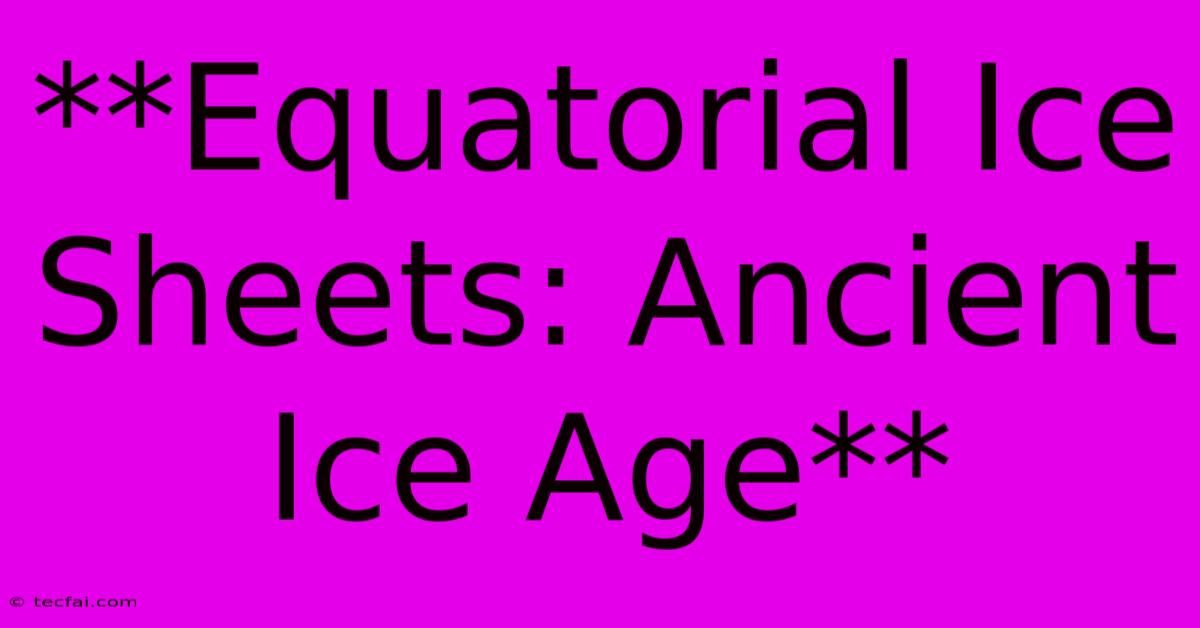**Equatorial Ice Sheets: Ancient Ice Age**

Discover more detailed and exciting information on our website. Click the link below to start your adventure: Visit Best Website tecfai.com. Don't miss out!
Table of Contents
Equatorial Ice Sheets: A Glimpse into Earth's Ancient Ice Age
The Earth we know today is a dynamic planet with a diverse range of climates. Yet, it wasn't always like this. Our planet's history is marked by periods of extreme climate shifts, including ancient ice ages when vast ice sheets extended far beyond the poles, even reaching the equator. While unimaginable in today's world, the presence of equatorial ice sheets is a compelling piece of Earth's geological puzzle, offering insights into the planet's past and potential future.
Uncovering a Frozen Past
The evidence for equatorial ice sheets is scattered across continents, meticulously collected by geologists and paleoclimatologists. These clues include:
- Glacial Till: Deposits of rock and sediment transported by glaciers, found in equatorial regions like Africa and South America, suggest the presence of glaciers in these areas.
- Striations: Scratches and grooves left by glaciers on bedrock, another hallmark of glacial activity, are found in regions that are currently tropical.
- Paleoclimate Data: Studying ancient sediments and fossils reveals evidence of past climates, including periods of extreme cold that support the existence of equatorial ice sheets.
Triggers of Equatorial Glaciation
The formation of equatorial ice sheets is a complex phenomenon driven by a confluence of factors:
- Orbital Variations: Slight changes in Earth's orbit, known as Milankovitch cycles, influence the amount of solar radiation received by different parts of the planet. During periods of low solar insolation, the tropics could have cooled significantly, triggering glacial formation.
- Continental Configuration: The arrangement of continents plays a crucial role in climate patterns. During past ice ages, the continents were positioned differently, potentially altering ocean currents and atmospheric circulation, creating conditions favorable for equatorial glaciation.
- Greenhouse Gas Concentrations: Changes in atmospheric greenhouse gas concentrations, such as carbon dioxide and methane, can significantly affect Earth's temperature. Low greenhouse gas levels during ancient ice ages could have contributed to the cooling necessary for equatorial ice sheets.
Implications for the Future
Understanding equatorial ice sheets is essential for comprehending Earth's climate system and its potential future. While the conditions that led to equatorial glaciation in the past are unlikely to occur in the near future, the study of these ancient ice ages provides valuable insights:
- Sensitivity of Climate: The existence of equatorial ice sheets highlights the sensitivity of Earth's climate to even slight changes in orbital variations, continental configurations, and greenhouse gas concentrations.
- Predicting Climate Change: Studying past climate shifts and their causes helps us develop more accurate climate models and better understand the potential impacts of future climate change.
Exploring the Unknown
While we have uncovered significant evidence for equatorial ice sheets, there are still unanswered questions:
- Exact Timing and Extent: Precisely when and how extensive these ice sheets were is still being researched.
- Impacts on Life: How did the presence of equatorial ice sheets affect the evolution and distribution of life on Earth?
Continuing research into equatorial ice sheets will shed further light on Earth's past and provide crucial insights into the complex workings of our planet's climate system, helping us navigate the challenges of a changing world.

Thank you for visiting our website wich cover about **Equatorial Ice Sheets: Ancient Ice Age**. We hope the information provided has been useful to you. Feel free to contact us if you have any questions or need further assistance. See you next time and dont miss to bookmark.
Featured Posts
-
Year End Tax Savings Free Webinar
Nov 14, 2024
-
Spanish Towns Face New Storm After Floods
Nov 14, 2024
-
Mc David Nears 1000 Points After Big Game
Nov 14, 2024
-
Longevity Assessments New Tool For Financial Planners
Nov 14, 2024
-
Thune Elected New Senate Republican Leader
Nov 14, 2024
